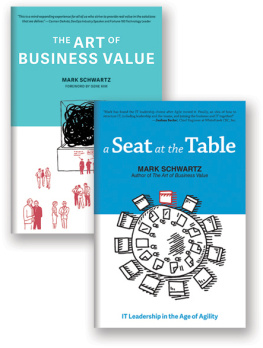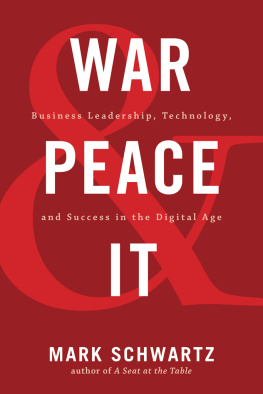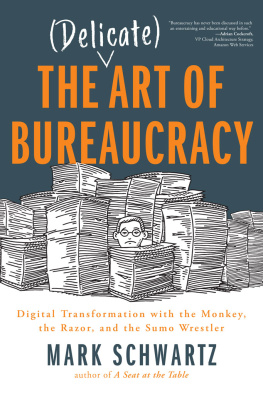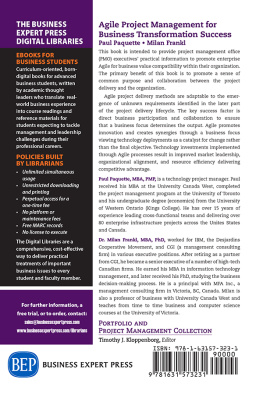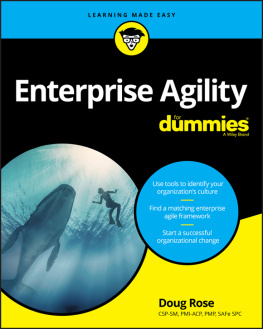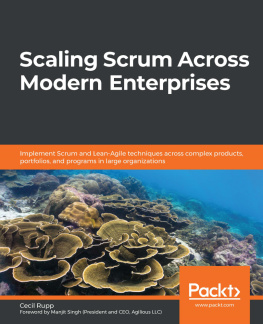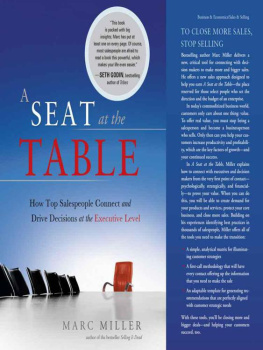
The Two Book Bundle of
a Seat at the Table
and
THE ART OF
BUSINESS VALUE
by
MARK SCHWARTZ

25 NW 23rd Pl, Suite 6314
Portland, OR 97210
A Seat at the Table Copyright 2017 by Mark Schwartz
The Art of Business Value 2016 by Mark Schwartz
All rights reserved, for information about permission to reproduce selections from this book, write to Permissions, IT Revolution Press, LLC, 25 NW 23rd Pl, Suite 6314, Portland, OR 97210
First Edition
Printed in the United States of America
10 9 8 7 6 5 4 3 2 1
A Seat at the Table cover design by Devon Smith
A Seat at the Table book design by Devon Smith
The Art of Business Value cover design by Stauber Design Studio
The Art of Business Value book design by Stauber Design Studio
The Art of Business Value illustrations by Lauren SimkinBerke
Author photograph by Gary Landsman
A Seat at the Table/The Art of Business Value bundle
TP ISBN: 978-1942788-553
eBook ISBN: 978-1942788-577
Kindle ISBN: 978-1942788-584
Web PDF ISBN: 978-1942788-560
For information about special discounts for bulk purchases or for information on booking authors for an event, please visit our website at ITRevolution.com.
A Seat at the Table/The Art of Business Value Bundle
Contents
a Seat at the Table
MARK SCHWARTZ
IT Revolution
Portland, Oregon
To the talented and hard-working government employees, so resilient in the face of impediments, criticism, and abuse. I have so much fun working alongside you.
CONTENTS
INTRODUCTION
The demand that I make of my reader is that he should devote his whole life to reading my works.
James Joyce, interview
Let these things be believed as resembling the truth.
Xenophanes, Fragments
A s I was writing my last book, The Art of Business Value , something at the back of my mind kept nagging me. It finally made its way onto the page in a chapter I wrote called The CIO, where I looked at the role of the CIO in delivering and defining business value. The issue, as I saw it at the time, was that Agile approaches seem to remove the CIOand the rest of IT leadershipfrom the value-delivery process.
For example, in Scrum, an Agile software development framework, the delivery team works directly with a product owner, who is generally drawn from the business. The product owner decides what will be valuable and works with the rest of the business to see that the value is harvested once the product is delivered. The delivery teamthe autonomous delivery teamfigures out the best way to deliver the solution. The team listens only to the product owner on questions of value.
Considering the above, what role does the CIO play in delivering value?
|
What is the relationship between IT and the business, and how does it change as we introduce Agile and Lean approaches? |
|
This question puzzled me, because I had previously thought that the CIO (me) had some responsibility for delivering IT value. This seemed to lead to a broader set of questions. Is the Agile team responsible for delivering business value, or is the product owner (or someone else drawn from the business) responsible for delivering business value, and the team responsible only for delivering product that will be used for delivering business value? Why do we need IT management? And if we do, how should they involve themselves in the delivery process?
The more I thought about these questions, the clearer it became that to answer them, I would first need to understand some more fundamental points: How does an IT department fit into its broader enterprise? What is the relationship between IT and the business. And, how does the relationship change as we introduce Agile and Lean approaches?
There are three main places to look for answers to these questions. The first is in the literature of the CIOthe many books, conferences, blogs, and podcasts on how to be an IT leader. What I found there was pretty much nothing at all; no discussion on what it meant to be an IT leader in the age of Agility, just a great deal of speculation on how to gain a seat at the table, or a recognition of ITs strategic value.
The second place to look is in the literature of Agile, Lean, and DevOps practices. There, I read that IT leaders had a role to play in driving the adoption of Agile practices in their organizations ... but then what? What was the role of the IT leader once Agile practices had been adopted?
The third place to look is in our own experiences, my personal experiences and those of my friends and associates. The best I could do was to reflect on my own mistakes as I bumbled around trying to figure out what I was supposed to be doing as an Agile CIO.
I think I can promise that every point I make in this book is an answer to some moment of dumbness in my career. I love the idea that I learned about in Chris Averys article, that in making an organization Agile one should provoke and observe. I have provoked, and I have observed.
|
The way the CIO role is defined, conceived, and executed today is incompatible with Agile thinking. |
|
What I have observed, mostly, is confusion. Martha Heller, in her book The CIO Paradox: Battling the Contradictions of IT Leadership , sums it up beautifully: the CIO role, and by extension the role of all IT leadership, is filled with contradictions and impossibilities. And when I reflected on the fact that Agilists dont talk much about CIOs and CIOs dont talk much about Agilists, the reason suddenly became clear to me. The reasonI thinkis that the way the CIO role is defined, conceived, and executed today is incompatible with Agile thinking.
There is a fundamental disconnect between the two. Interestingly, I find that the way the CIO role is defined, conceived, and executed today is incompatible with pretty much everything, particularly the delivery of business value. That, perhaps, is the point of Hellers book.
That is why this book is filled with hope. I believe that if we re-conceive the role of IT leadership based on Agile principles, we can make sense of all this confusion and turn IT into a value-creation engine. Agile, Lean, and DevOps approaches are radical game changers. They are a different way to think about how IT fits into the enterprise, a different way to think about how IT leaders lead, and a different way to think about harnessing technology to accomplish the objectives of the enterprise.
The worst thing we can do is to try to squeeze Agile ideas about project execution into a business context that was created with Waterfall approaches in mind. Unfortunately, that is what we do. The Waterfall, I will show, is so deeply ingrained in the way we think about IT leadership that we barely notice it. On the other hand, by importing Agile ideas into the leadership context, we can align delivery with management, oversight, governance, risk management, and all the other things that IT leaders have always worried about.

It seems to me that honest and open conversations are not taking place at the interface between management and Agile delivery teams. The important questions are obscured by rhetoric that says, We need immediate cultural change so that we can become Agile! That attitude, as I pointed out in The Art of Business Value , is strangely non-Agilewhat we really need to do is experiment and learn about how an Agile approach to IT works within the broader business context that is the enterprise.
Next page
